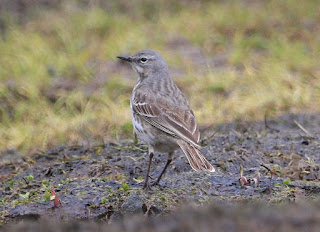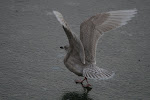I have now been to Spain every year since 2006, but always go in August (except in April 2008), so this was the first trip in May.
We flew out from Manchester with RyanAir and landed in Girona (Barcelona) on the Friday evening, and drove to Empuriabrava. We stayed in the Xon's Platja hotel and hired an Opel Corsa from Europcar, both of which being completely adequate for our needs
We got up bright and early on Saturday and visited Aiguamolls de l'Emporda, starting at the back of the reserve at El Mata. Highlights from this part of the reserve were 3 Glossy Ibis, 7 Squacco Heron, Great Reed Warbler, Whiskered Tern and a superb male Little Bittern. Throughout the rest of the reserve, there was a constant chorus of Nightingale, Cetti's Warbler, Fan-tailed Warbler and the bill clapping of the ubiquitous White Stork.
There was an almost complete lack of any mud so Wood Sandpiper, Green Sandpiper, Ringed Plover, Little Ringed Plover and Black-winged Stilt constituted the only waders.
We therefore decided to venture away from the main reserve and check out Estany de Vilaut where we saw lots of Melodious Warbler, Great White Egret, Cattle Egret, Spoonbill, Little Egret, Purple Heron, Grey Heron. Highlights here were adult White-winged Black Tern, Red-crested Pochard and Garganey.
We ended the day at Estanys de Europa where I got my first lifer of the trip, in the form of 2 female LITTLE CRAKE. I have wanted to see these at Aiguamolls for years, but have always been unlucky. A great bird to see. In addition to this, we saw 2 Little Bittern and several Great Reed Warbler sang around the reserve.
Day 2 saw Kane and I drive up to Val de Nuria in the Pyrenees. The drive up to the valley saw me look into a field of Stork, and notice a darker bird. It was a BLACK STORK! I believe this bird is ringed and has been present in the area all spring. All that I was concerned about was that this was my second lifer of the trip. I visited Nuria with my dad, back in 2010. The weather back then was distinctively horrific with almost constant mist up at the hotel and constant torrential rain and lightning on the walk down the valley. Annoyingly, 2012 saw very similar weather, which prevented us from walking down the valley to target Wallcreeper. There were regular breaks in the mist, so was able to some birding in patches on the top.
I picked up several singing Ring Ouzel and Water Pipit, as well as Rock Bunting, Rock Thrush, Wheatear, Citirl Finch, Common Crossbill, Mistle Thrush, Dunnock, Griffon Vulture, Crag Martin, Dipper and Raven. The regular mist cover didn't allow for much Raptor scanning, but just as we had lost hope and were waiting to board the train down the valley, I caught sight of a shape in the corner of my eye. My heartbeat increased as I got my first view on it, as massive wings and a huge diamond-shaped tail revealed the unmistakable shape of my first ever LAMMERGEIER. What a fantastic bird...the single bird of the trip for me.
On the train down, I knew which rock face to look for Wallcreeper so that's what I did. As we passed the Torrent de Fontable, I picked up movement on one of the cliff faces. I lifted my bins and saw a small bird 'flicking' its wings revealing penetratingly scarlet colouration. This could only be one thing...my first WALLCREEPER!
The Ring Ouzel up in the Pyrenees seemed to have a more scaley appearance than the British birds, making these of the race alpestris.
I knew that Nuria is a fantastic place for Butterflies and Fauna, so was slightly disappointed to see the weather being so bad. One surprise was the mammals up at the top, which included Alpine Marmot and Spanish Ibex. These are two species I have wanted to see in the back of my mind for a while now.
Day three saw continued rain when we woke up, but whilst at Estany de Vilaut, there was an hours period where the sun almost came out which set up the birding highlight of the trip for me. Something I have always wanted to see was the Honey Buzzard Migration, and I was able to see, in an hours period, 79 Honey Buzzard moving North East. This featured occasional flock of birds including a flock of 18 birds, as well as 11, 4, 3, 2, and then singles. These flocks all contained only Honey Buzzards except an addition flock of 3 with 2 Black Kites present. It was incredibly educational to see Honey Buzzards, Black Kite and Common Buzzards in the same scan, as the jizz are all three species couldn't be much more different when you see them side by side.
I visited Vilaut a second time, because I had visited a local sightings blog in an Internet cafe and discovered three RED-FOOTED FALCONS were present on the reserve. A second visit here saw distant views of two bird (male and female) which were certainly acceptable.
We ended the birding for the holiday at the lighthouse at the Cap de Creus. Here I did a spot of seawatching which reveal a fantastic passage of three Shearwater sp heading North East. The main passage seemed to be of mediterranean shearwaters of which 50% were identifiable to specific species, however the other 50% were either too distant or too intermediate to be able to make an executive decision of ID. Of the identifiable birds though, I would suggest the passage seemed to be 65% Yelkouan Shearwater and 35% Balaeric Shearwater. A smaller passage of (Scopoli's) Cory's Shearwater. The paler base to the primaries of Scopoli's race (diomedea) was evident even at this range. A very educational seawatch indeed.
In addition to the shearwaters, I got my best views ever of Black-eared Wheatear and Tawny Pipit.
diomedea Cory's Shearwater
Massive thanks to Kane Brides for the holiday and for doing all the driving. I had a fantastic time, despite the almost continuous rain and lack of any mud for waders. We ended the trip on 141 species and 5 lifers (for me) which is my 2nd best total for NE Spain, which is fantastic given the bad conditions and very short 3 day trip!


















No comments:
Post a Comment